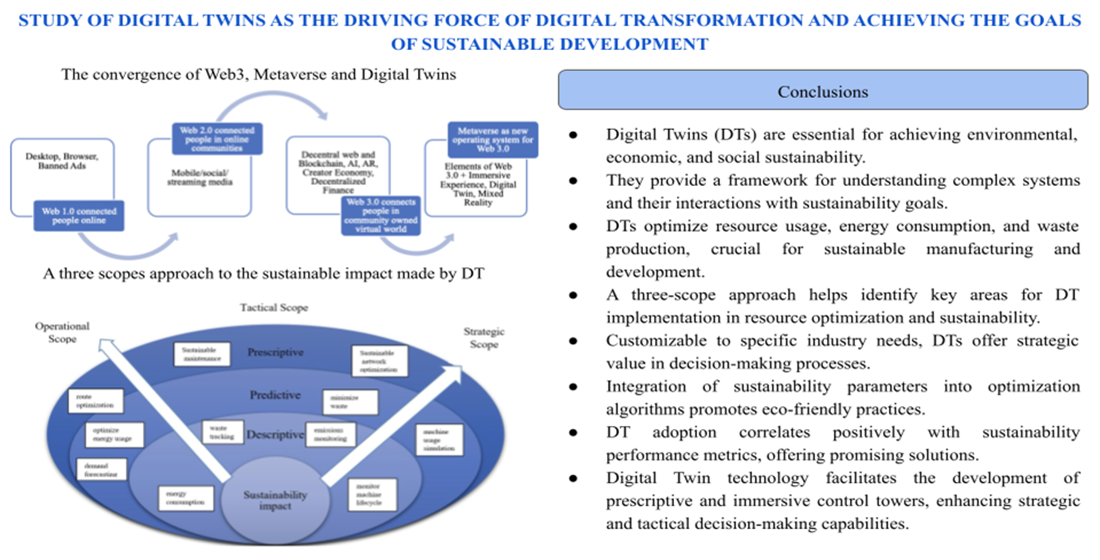Study of digital twins as the driving force of digital transformation and achieving the goals of sustainable development
DOI:
https://doi.org/10.15587/2706-5448.2024.301423Keywords:
digitization, digital twins, digital transformation, sustainable development, digital economyAbstract
The object of research is the use of Digital Twin (DT) technology in the manufacturing sector and its impact on sustainability. The scientific problem addressed is the identification and quantification of the potential advantages and challenges associated with the adoption of DTs at operational, tactical, and strategic levels, particularly in the context of sustainable development. The paper investigates how DTs can redefine the measurement of sustainable development and diversify implementation within manufacturing infrastructure. The study concludes that DTs are a sophisticated technology that enables manufacturers to create precise virtual replicas of physical products or processes. This helps in optimizing resource utilization, reducing energy consumption, and minimizing waste, thereby promoting sustainability.
Main DT clusters and common uses highlighted by the authors demonstrate huge impact on energy efficiency, waste management, sustainable design, logistics emissions reduction, water conservation, and stakeholder engagement. It is proved that DTs simulate and analyze complex systems, enabling the evaluation and improvement of sustainability levels. The paper presents promising practical examples of DT’s use, such as optimizing warehouse management in Ukraine, automating robots for increased efficiency, and aiding in the post-war reconstruction of cities with a focus on environmental friendliness and accessible infrastructure.
The research specifically focuses on the top five tech giants and their use of DTs to drive sustainability. Additionally, the findings project substantial market growth potential for DTs in multiple sectors, emphasizing the urgent need for industries to integrate DTs into their sustainability strategies.
References
- Digital twins: The key to smart product development (2023). McKinsey Insights. Available at: https://www.mckinsey.com/industries/industrials-and-electronics/our-insights/digital-twins-the-key-to-smart-product-development
- Abdoune, F., Ragazzini, L., Nouiri, M., Negri, E., Cardin, O. (2023). Toward Digital twin for sustainable manufacturing: A data-driven approach for energy consumption behavior model generation. Computers in Industry, 150, 103949. doi: https://doi.org/10.1016/j.compind.2023.103949
- Wang, C., Miller, D., Gimona, A., Nijnik, M., Jiang, Y. (2023). An integration of digital twin technology, GIS and VR for the service of environmental sustainability. doi: https://doi.org/10.5194/egusphere-egu23-5626
- He, B., Mao, H. (2023). Digital Twin-Driven Product Sustainable Design for Low Carbon Footprint. Journal of Computing and Information Science in Engineering, 23 (6). doi: https://doi.org/10.1115/1.4062427
- Mäkitie, T., Hanson, J., Damman, S., Wardeberg, M. (2023). Digital innovation’s contribution to sustainability transitions. Technology in Society, 73, 102255. doi: https://doi.org/10.1016/j.techsoc.2023.102255
- Kasych, A., Yakovenko, Y., Tarasenko, I. (2019). Optimization of Business Processes with the use of Industrial Digitalization. 2019 IEEE International Conference on Modern Electrical and Energy Systems (MEES), 222–225. doi: https://doi.org/10.1109/mees.2019.8896531
- Yakovenko, Y., Shaptala, R. (2023). Intelligent process automation, robotic process automation and artificial intelligence for business processes transformation. Globalisation Processes in the World Economy: Problems, Trends, Prospects. Riga: Baltija Publishing, 496–521. doi: https://doi.org/10.30525/978-9934-26-378-1-20
- Saracco, R. (2019). Digital Twins: Bridging Physical Space and Cyberspace. Computer, 52 (12), 58–64. doi: https://doi.org/10.1109/mc.2019.2942803
- Hüsener, D., Schluse, M., Kaufmann, D., Roßmann, J. (2022). The Digital Twin as a Mediator for the Digitalization and Conservation of Expert Knowledge. Annals of Scientific Society for Assembly, Handling and Industrial Robotics 2021, 241–251. doi: https://doi.org/10.1007/978-3-030-74032-0_20
- Vohra, M. (2022). Overview of Digital Twin. Digital Twin Technology, 1–18. doi: https://doi.org/10.1002/9781119842316.ch1
- Kaarlela, T., Pitkäaho, T., Pieskä, S., Padrão, P., Bobadilla, L., Tikanmäki, M. et al. (2023). Towards Metaverse: Utilizing Extended Reality and Digital Twins to Control Robotic Systems. Actuators, 12 (6), 219. doi: https://doi.org/10.3390/act12060219
- Vailshery, L. S. (2023). Digital twin – statistics & facts. Statista. Available at: https://www.statista.com/topics/9847/digital-twin/#topFacts
- Digital Twin Market Size, Share, Competitive Landscape and Trend Analysis Report by Type (System Digital Twin, Product Digital Twin, Process Digital Twin), by Industry: Global Opportunity Analysis and Industry Forecast, 2021–2030. Available at: https://www.alliedmarketresearch.com/digital-twin-market-A17185
- Rojek, I., Mikołajewski, D., Dostatni, E. (2020). Digital Twins in Product Lifecycle for Sustainability in Manufacturing and Maintenance. Applied Sciences, 11 (1), 31. doi: https://doi.org/10.3390/app11010031
- Elias, D., Ziegenbein, D., Mundhenk, P., Hamann, A., Rowe, A. (2023). The Cyber-Physical Metaverse – Where Digital Twins and Humans Come Together. 2023 Design, Automation & Test in Europe Conference & Exhibition (DATE). doi: https://doi.org/10.23919/date56975.2023.10137285
- Hasan, M. (2023). Digital twin market: Analyzing growth and emerging trends. IoT Analytics. Available at: https://iot-analytics.com/digital-twin-market-analyzing-growth-emerging-trends/
- Mourtzis, D. (2023). Digital twin inception in the Era of industrial metaverse. Frontiers in Manufacturing Technology, 3. doi: https://doi.org/10.3389/fmtec.2023.1155735
- How digital twin technology is transforming supply chains (2020). EY Report. Available at: https://www.ey.com/en_ae/consulting/how-digital-twin-technology-is-transforming-supply-chains
- Wright, L., Davidson, S. (2020). How to tell the difference between a model and a digital twin. Advanced Modeling and Simulation in Engineering Sciences, 7 (1). doi: https://doi.org/10.1186/s40323-020-00147-4
- Birch, D., Medoff, J.; Solomon, L. C., Levenson, A. R. (Eds.) (1994). Labour Markets, Employment Policy and Job Creation. Westviews Boulder, Co, 159–168.
- The Premier Research Platform for Long Term Investors. (2024). Macrotrends. Available at: https://www.macrotrends.net/
- Kilroy, A. (2023). A Guide to Understanding ESG Ratings. Available at: https://finance.yahoo.com/news/guide-understanding-esg-ratings-151501443.html
- Henrekson, M., Johansson, D. (2009). Gazelles as job creators: a survey and interpretation of the evidence. Small Business Economics, 35 (2), 227–244. doi: https://doi.org/10.1007/s11187-009-9172-z
- Baiocchi, G., Distaso, W. (2003). GRETL: Econometric software for the GNU generation. Journal of Applied Econometrics, 18 (1), 105–110. doi: https://doi.org/10.1002/jae.704
- What is digital-twin technology? (2023) McKinsey. Available at: https://www.mckinsey.com/featured-insights/mckinsey-explainers/what-is-digital-twin-technology#/

Downloads
Published
How to Cite
Issue
Section
License
Copyright (c) 2024 Yaroslava Yakovenko, Roman Shaptala

This work is licensed under a Creative Commons Attribution 4.0 International License.
The consolidation and conditions for the transfer of copyright (identification of authorship) is carried out in the License Agreement. In particular, the authors reserve the right to the authorship of their manuscript and transfer the first publication of this work to the journal under the terms of the Creative Commons CC BY license. At the same time, they have the right to conclude on their own additional agreements concerning the non-exclusive distribution of the work in the form in which it was published by this journal, but provided that the link to the first publication of the article in this journal is preserved.







